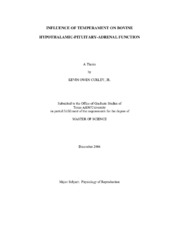| dc.description.abstract | Measures of temperament including exit velocity (EV) and pen score (PEN) and were compared over 3 repeated observations (60-d interval) of yearling Brahman bulls (initial BW = 320 ± 4 kg; n = 66). Exit velocity measures were correlated; EV1 to EV2 (r = 0.32, P = 0.01), EV1 to EV3 (r = 0.31, P = 0.02), and EV2 to EV3 (r = 0.47, P < 0.001). Both EV and PEN were correlated with serum cortisol (CS) within Time 1 and Time 3; EV1 to CS1 (r = .26, P = 0.04), PEN1 to CS1 (r = 0.29, P = 0.02), and EV3 to CS3 (r = 0.44, P < 0.001).
Two-year old Brahman heifer were given an ACTH challenge. The calm (C) and temperamental (T) groups consisted of 6 slow (EV=1.05 ± 0.05 m/sec) and 6 fast (EV = 3.14 ± 0.22 m/sec) heifers. Prior to ACTH challenge, T heifers had elevated CS (T = 48.97 ± 3.42, C = 29.60 ± 5.46 ng/mL). Basal CS was higher (P < 0.001) in T heifers (18.20 ± 2.63, C = 4.30 ± 0.58 ng/mL). Following ACTH (0.1 IU ACTH per kg BW) area under the response curve (AUC) was greater (P = 0.07) in C heifers (T = 69.08 ± 10.69, C = 95.87 ± 7.24 ng·h/mL). After declining below basal concentrations, CS in T heifers were again greater (P = 0.02) than in C heifers.
The same heifers were subjected to a CRH challenge (0.1 µg bCRH per kg BW). Prior to CRH area under the ACTH curve was greater (P = 0.025) in T heifers (T = 385.72 ± 49.97, C = 239.24 ± 24.04 pg·h/mL). Basal ACTH did not differ (P = 0.10) between temperament groups. Area under the ACTH response curve was greater (P = 0.057) in C heifers (C = 66.72 ± 10.65, T = 38.11 ± 6.44 pg·h/mL).
These data demonstrate that cattle with poor temperament exhibit increased stress responsiveness to handling, increased baseline adrenal function but not increased basal pituitary function, and a muted responsiveness to pharmacological stimulus. Thus functional characteristics of the HPA axis vary with animal temperament. | en |


